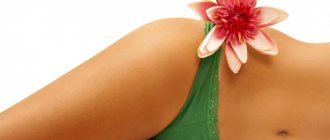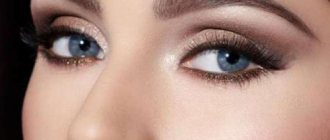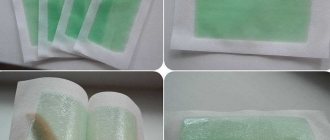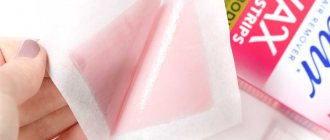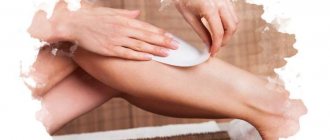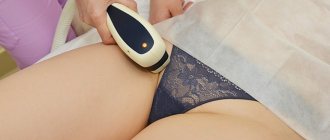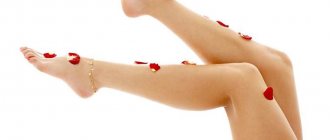Modern girls try to take care of their appearance. This takes a lot of money and a lot of time. Many people have an acute question about choosing a method for removing excess hair, and there are many of them: waxing, sugaring, laser, and so on. In this article we will tell you about waxing at home.
This is one of the most popular ways to get rid of excess vegetation. Her success among girls was ensured by the simplicity, relative painlessness, accessibility and durability of the effect. Waxing is often called waxing. This is a great option for removing excess hair on the chest, arms, legs, bikini area or stomach.
Hair removal with wax is a safe procedure that is easy to perform. In the process, you remove not only the visible part of the hair, but also the root (that is, you remove the hair completely, unlike a razor).
How does the wax depilation procedure work at home:
- Using a special spatula, wax is applied to the selected area of skin (it should not be too large);
- Wait the time indicated on the package;
- With a sharp movement, like a band-aid, tear off the wax along with excess vegetation.
Waxing: types
There are three types of waxing: hot wax, warm and cold. Each of them differs not only in temperature, but also in the method of application. Let's look at everything, start with a cold one.
Waxing with cold wax
It is the simplest and most accessible. Its advantage is that there is no need to heat the wax, apply it to the skin and glue the strips. The strips are sold ready-made, along with wax. All you need to do is warm the strip with your palms to body temperature. Then the strip is separated into two parts and glued to the skin. This must be done very carefully and be sure to follow the growth of the hair and press it tightly to the skin. Then quickly and sharply pluck against hair growth. You need to repeat until the last hair on the selected part of the body. The wax is removed from the skin very easily - just wipe it over the treated area with a cosmetic napkin. If there are single hairs left that the wax did not capture, take tweezers and pluck them out. To get the perfect result, carefully inspect the depilated area for any remaining hairs somewhere on the knee.
Waxing: warm method
This method is a little more complicated, but it is no less accessible than the previous one. The warm type of waxing is done using commercial wax. It is easy to find on the shelves of household chemicals and cosmetics stores. As a rule, the product is made from resin (mostly pine), white beeswax or honey. Sometimes several bases are combined with each other. Components are often added to relieve irritation and soothe delicate skin. There is no need to heat this wax too much; a temperature of 37-38 degrees Celsius will be enough. For this purpose, there are so-called “Wax melters” - devices specially created for this purpose. Such a machine will maintain the desired temperature and consistency, but will not overheat.
Often the mixture is sold in special cassettes - this is very convenient, because there is no need to fiddle with a spatula and worry about the thickness of the applied layer. If you like the process of applying wax to the skin, the classic version in simple jars is suitable for you.
Residues of warm wax are easily removed from the skin using oil products. Others will be ineffective. Waxing at home with a warm product is not suitable for all areas of the skin: bikini, upper lip and armpits, for example. This is an excellent product for removing hair from arms or legs.
Hot method
The name comes not from the fact that the wax is applied to the skin very hot, but because it is heated in a special apparatus to a high temperature (about 45-47 degrees Celsius). After heating, the wax is allowed to cool slightly so as not to damage the skin. You need to be very careful with this, especially in delicate areas (armpits, bikini, deep bikini). If you apply the mixture to your skin very hot, you can easily get an unpleasant burn. But the procedure itself is less painful, unlike the two previous methods.
How to do waxing correctly:
- Heated wax is applied to the skin along the hair growth;
- Wait a while for the wax to harden (the manufacturer will indicate exactly how long);
- Tear off with a sharp movement against the hair growth.
Another advantage of this method is that you don’t have to worry about the stripes - the frozen wax looks like plasticine and is easy to tear off with your hands.
If you are afraid of getting burned, you can purchase special cassettes and wax melters. They will greatly simplify the waxing procedure at home. The hot method is perfect for delicate areas (bikini or armpits), but also works great for depilating arms, legs, abdomen or face. You can purchase wax in solid form in granules (the fastest option, melts faster), cassettes, and tablets.
Depilation and hair removal
Smooth velvety skin of the legs, bikini, armpits, absence of unwanted hair on the face - all these are components of female beauty.
To keep your skin well-groomed, the issue of hair removal must be approached responsibly. Aggressive methods of hair removal - home depilation using electric depilators, shaving - injure delicate skin, cause irritation and even inflammation, disrupt its natural protection, which is why the skin loses moisture, does not have time to recover, and ages quickly. Therefore, today cosmetology offers gentle and more effective ways to get rid of unwanted hair. Depilation is the temporary removal of hair; this technique includes depilation with sugar paste (sugaring) and waxing. Both procedures are done either at home or in a beauty salon or beauty clinic. Self-conducted procedures, although they allow you to save on paying for specialist services, are often carried out not very carefully, hair is not completely removed, side effects can occur (irritation, ingrown hairs), and the duration of such procedures is much longer than salon ones. In beauty salons, depilation is carried out by trained and certified professionals. In a medical facility, depilation is carried out in sterile rooms fully equipped with modern equipment by specialists with special education and extensive experience - therefore, it is in clinics that this service is provided with the highest quality.
The clinic on Komarova invites you to a wax or sugar depilation procedure. The session is conducted in a comfortable environment by an experienced, qualified specialist.
Also at the clinic on Komarova you can undergo the procedure removal - long-term hair removal (laser, photo radiation).
Waxing at home: what to do before and after
If this is your first experience at home, prepare in advance:
- A couple of days before depilation, exfoliate the selected area of skin with a scrub. Do not rub too hard so as not to injure the skin with hard particles and aggravate it during depilation;
- Right before the procedure, it is very important to clean the selected area of dust, sebum and dirt;
- Do not forget to degrease the skin, otherwise the wax will not “set”. The best option would be: take a shower (preferably hot), wipe your skin dry and apply a thin layer of powder (without fragrances!);
- If you can’t run into a shower or bath, wipe your skin with lotion or tonic, remove excess with a towel and sprinkle talcum powder or other product on top.
Important: during menstruation, the body is more sensitive to pain. If you are already very sensitive to various effects on the skin, you should postpone depilation.
Forms of release of wax compositions for hair removal
Wax in granules. This product, used for depilation, has a low melting point and forms a kind of film on the skin, which, after hardening, breaks off, taking the hair with it. The advantages of depilation with granules include minimizing the risk of burns, economical consumption of the composition, the possibility of carrying out the procedure on delicate areas of the body, as well as maximum smoothness of the skin.
Depilatory wax in cartridge. This form of supplying the waxy mixture is very convenient and safe, since it is impossible to accidentally turn it over, like wax in a jar. When using this form, the depilatory product can be easily placed in a wax melter, and then easily distributed over the skin in as even a layer as possible. The composition is hypoallergenic, has anti-inflammatory properties, perfectly moisturizes the dermis and is recommended for sensitive areas.
Wax in cassettes. This is a kind of innovation in the field of waxing. However, the cassettes are not endowed with any special specifics, except that for many they represent the greatest convenience during heating in a wax melter. Otherwise, the mixture is still applied to the hair using a roller, and then the hair is removed with special paper strips.
pexels.com/
Waxing: how to do it right
- The length of the hairs should be about 4-5 millimeters. Only in this case the result will be as high as possible. If the hairs are shorter, the wax may simply not capture them. If the hairs have grown even longer, it is worth cutting them to the desired length for the same reason. This is not very convenient, so it is better not to miss the moment;
- Don’t forget to apply fragrance-free powder to the entire selected area;
- Determine the direction of hair growth in the selected area;
- Apply wax along the direction of growth. Try to do this in wide and long, but dense stripes;
- Place a special strip on top of the wax. This item is needed for depilation with warm wax;
- Against the growth of the hair, with a sharp and confident movement, tear off the strip along with the wax. The sharper you do this, the higher the effectiveness and the less pain it will be - it works like a band-aid;
- Repeat until you have treated the entire selected area;
- Remove any remaining wax with a cosmetic wipe. Do not rub the skin after depilation with a washcloth and soap - this will only increase irritation and discomfort after the procedure;
- Immediately after waxing, it is recommended to apply a soothing and moisturizing lotion to the skin. You can use cream or gel, but it is better to avoid greasy products. Irritation after the procedure will remain on the skin for some time (up to two days is considered normal);
- It is not recommended to wet the skin for the next 6 hours after hair removal, as this may increase irritation and increase the risk of infections on injured skin;
- During the day you should not sunbathe, go to the solarium, take hot baths or swim in the river or sea;
- Do not use cosmetics that contain alcohol or synthetic fragrances. They can cause allergies or ingrown hairs;
- You can peel the skin only after 3-4 days for the reasons described in the paragraph above;
- To prevent future ingrown hairs and speed up recovery, exfoliate your skin several times a week.
The result after the procedure lasts quite a long time (from two weeks to a month and a half - everything is very individual and over time, hair growth slows down, and the hairs themselves lighten).
Eyebrow correction with wax contraindications
Wax correction is great for thick, too wide or “fluffy” eyebrows with a lot of unnecessary hairs around the edges. The wax easily captures all excess, leaving the skin smooth. As a result, eyebrows remain clear, neat and expressive for a long time.
Before performing the procedure, be sure to check if you have any contraindications:
- Inflammations, wounds or cuts in the eye and eyebrow area are contraindications for eyebrow waxing.
Intolerance to bee products; - Inflammations, wounds or cuts in the eye and eyebrow area;
- A large number of moles in the T-zone;
- Circulatory disorders;
- Skin diseases in the acute stage, severe skin irritation.
If there are no contraindications, but you want to make your eyebrows beautiful, then all you have to do is choose an experienced eyebrow artist who will not make the mistakes of a beginner. And, of course, in order to avoid a “disaster”, you should not correct your eyebrows with wax yourself.
This correction is best done when you have already decided on the shape of your eyebrows . After all, if the shape doesn’t suit you, it will take quite a long time to grow it .
- The procedure requires maximum precision and accuracy. If you catch extra hairs, you will have to wait a long time for them to grow back;
- After correction with wax, the skin turns red for a while. Usually the redness goes away after a couple of hours, but it all depends on the individual characteristics of the body;
- If the wax is too hot, you may get burned;
- If wax residues are poorly removed after correction, it can cause skin irritation.
As you can see, almost all the disadvantages of wax correction are associated with the experience of the specialist. A competent and experienced eyebrow artist will never remove excess hair, will not use wax that is too hot, and will carefully remove any remaining wax from the skin after the procedure.
Sources
https://pilochka.ua/protivopokazaniya-dlya-depilyacii/
Beeswax: use in folk medicine, composition, how it is formed, needed, where it is used, applied, benefits and harms, shelf life
https://broviresnicy.ru/page/korrekcija-brovej-voskom
https://pchelgid.ru/chem-polezen-pchelinyj-vosk/#i-13
https://vualia salon.ru/korrektsiya-tela-i-litsa/polimernyj-vosk-dlya-depilyatsii-chto-eto-takoe-kakoj-kupit-otzyvy-kak-polzovatsya-protsedura.html#i-22
How to do wax depilation correctly: analysis of individual zones
Each part of our body is individual, each requires a separate approach. Waxing on the legs and bikini area cannot be done using the same principle. It will either be very painful or ineffective. Let's start with the simplest.
Leg hair removal
- Warm or hot wax is perfect for this area;
- Take a warm bath to prepare your skin for the harsh effects of the wax. Hot water will expand the pores and make it easier to remove hair from the root, with the bonus of reducing pain;
- Run the washcloth several times against the hair growth, this will help the ingrown hairs “come out”;
- Degrease and disinfect the skin with a cosmetic product that does not contain alcohol;
- Apply wax to the skin in small sections and stick on the strips. Make sure they stick well to the wax;
- Important: leave a small piece at the bottom “unglued” - this will make it easier to catch and tear off the strip along with the wax;
- Do not use the same strip twice.
What equipment is used for laser hair removal?
In articles and reviews about laser hair removal you can often find the phrases “hair removal with a diode laser”, “hair removal with an alexandrite laser”, etc. Is there a difference between this equipment?
Yes, there are differences, and significant ones. Each type of laser emits light pulses at a specific wavelength. Characteristics such as flash duration, energy flux density, and pulse frequency are also important. Therefore, the type of radiation must be selected by a doctor - cosmetologist, laser therapist - individually for each patient, taking into account his skin type and hair color.
Types of modern laser systems:
Ruby laser is effective for eliminating dark hair on skin types I and II (according to the Fitzpatrick table). This is a fairly old type of laser and is difficult to find in modern clinics. During processing there is a risk of tissue burns. It is considered a relatively inexpensive type of hair removal.
Alexandrite laser is more suitable for working with skin types I-IV. Great for removing dark hair (even on lightly tanned skin) but may not work on depigmented hair. Due to its good performance and relatively low cost, the alexandrite laser hair removal service is one of the most popular today.
Diode laser does not guarantee complete elimination of gray hair, but can be used to remove dark, red and light hair (with sufficient melanin content) on absolutely all skin types. This is one of the most effective types of laser hair removal combined with an adequate cost.
Neodymium laser - used for skin types III-VI; tanned skin can also be treated. It has proven its high effectiveness in removing hair of different colors and structures, including weakly pigmented and vellus hair. The relative disadvantage of this type of laser hair removal is that the treatment takes longer and is more expensive.
At the MedikCity clinic, laser hair removal is performed by highly qualified cosmetologists using the SYNCHRO PLAY system developed by the Italian company DEKA, a world leader in the production of equipment for laser and plastic surgery.
This unique installation combines several types of lasers, which makes it possible to carry out procedures for patients with any skin color and hair type, as well as additionally use the photoepilation mode. The equipment is equipped with a built-in cooling system, which makes laser hair removal painless and ensures no skin irritation.
1 Laser hair removal
2 Laser hair removal
3 Laser hair removal
Waxing: how to do the bikini area
- Take hot or cold wax;
- Thoroughly clean the area of any contaminants. Be careful, as the skin is delicate and can be irritated by friction with linen and clothing;
- Avoid using alcohol-containing products and synthetic fragrances - they can cause allergies, acne and increase irritation;
- An important point: hairs in the bikini area should not be more than half a centimeter;
- Glue the strip diagonally, since in this area the hairs usually grow in this direction;
- If skin irritation occurs after treatment, apply an appropriate product to the skin.
Many girls worry about the safety of depilation in this intimate area, but there is no need to worry. If everything is done correctly, the skin becomes smooth and silky; over time, the hairs lighten, become thinner and stop growing.
How to properly wax your face
- Use cold wax. Special strips for removing excess hair from the face are often sold on store shelves;
- Cleanse the skin of impurities and sebum;
- Apply the strip to your face and press firmly to the skin;
- With a sharp and quick movement, tear the wax off the skin;
- Apply moisturizer.
Wax general information
Beeswax is a product of the activity of bees.
It is produced when honey is collected by hive bees at the age of 12-18 days. For its production, pollen is synthesized. Beeswax is a product of the activity of bees. It is produced when honey is collected by hive bees at the age of 12-18 days. For its production, pollen found in nectar is synthesized. It is secreted from wax glands located in pairs on the abdomen of the insect.
The chemical composition of wax is represented by more than 300 minerals and biologically active compounds. Contains water in small quantities (0.1-2.5%), carotenoids, minerals and foreign impurities.
Minerals are represented by 4 groups of organic compounds, each of which, in turn, consists of several components. We can highlight:
- alkanes (saturated hydrocarbons) – 10-13%;
- free fatty acids – 13.5-14.5%;
- high molecular alcohols – 1-1.25%;
- esters – up to 75%.
In wax, only 21 compounds exceed a concentration of 1%, which is 56% of its composition. The remaining 44% accounts for about 280 minerals and compounds. Therefore, many of them are presented only in the form of traces.
The presence of fatty (carboxylic) acids when wax interacts with metals changes its color. So, iron colors it brown, copper gives it a green color, and zinc gives it a dirty gray color.
Waxing: contraindications
- Injuries in the treated area: scratches, wounds, cuts, abrasions, bruises, and so on;
- Inflammations or pustules, as well as herpes;
- Moles, warts, papillomas or birthmarks on the selected area;
- Diabetes mellitus or epilepsy;
- Pregnancy and lactation;
- Problems with blood clotting.
Now you know all the intricacies of wax depilation at home. It is done easily and quickly enough if you get used to it. The result is long-lasting, and the materials themselves are relatively inexpensive. The main thing is don’t be afraid and everything will work out for you!
Contraindications for waxing
It is worth mentioning here that we are not referring to individual zones, but specifically to certain areas of the skin that cannot temporarily be subjected to waxing, since this procedure is extremely traumatic for them:
- irritated or damaged skin;
- the place where Retin-A ointment was applied;
- phlebeurysm;
- skin affected by rashes, wounds, pimples, moles, warts, herpes, etc.;
- skin after dermabrasion, which was performed less than three months ago;
- areas of the body after Botox, which was performed less than a week ago;
- those areas of the body where waxing has already been done less than a day ago;
- areas where there is piercing;
- areas with tattoos, especially fresh ones.
You can see many of the effects of wax hair removal in photos on the Internet, the effect, so to speak, on the face and even on the face. By the way, above the upper lip the side effects of wax appear especially “brightly”, ranging from redness for several days to severe peeling.
If you have any questions, be sure to go for a consultation at our salon in Moscow. Our best specialists will tell you how to avoid negativity after waxing and how to eliminate all complications.

